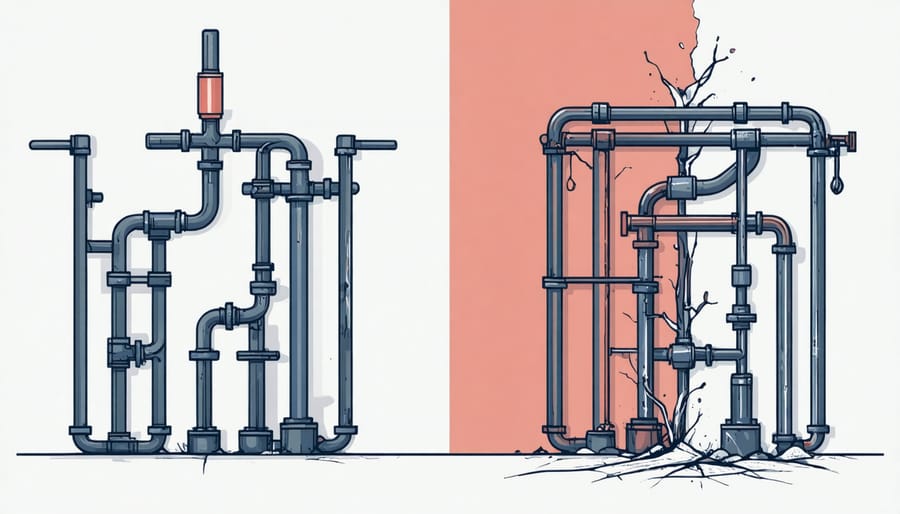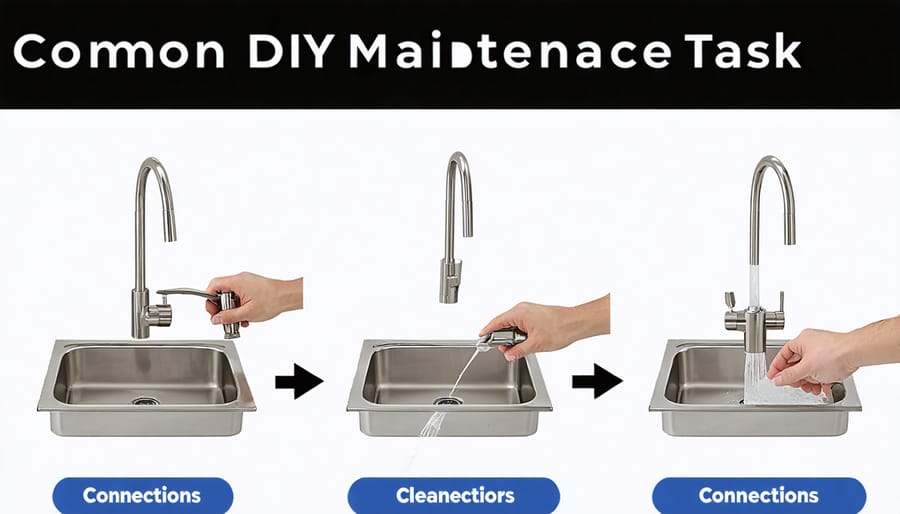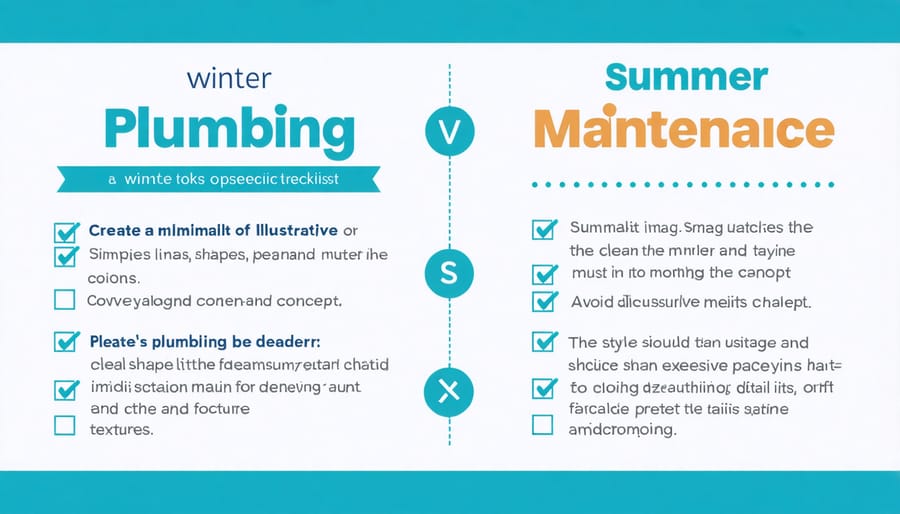Protect your home’s plumbing system and save thousands in repairs through strategic preventive maintenance. Regular inspections, timely repairs, and proactive care prevent catastrophic failures and extend the lifespan of your plumbing infrastructure. Smart homeowners know that catching small issues early transforms expensive emergency calls into manageable maintenance tasks.
Think of preventive plumbing maintenance as your home’s health insurance policy. Just as regular check-ups help maintain your well-being, scheduled plumbing inspections safeguard your property from water damage, mold growth, and structural issues. From simple tasks like checking for leaks and clearing drains to professional annual inspections, a comprehensive maintenance strategy keeps your plumbing system running smoothly year-round.
This guide reveals essential preventive maintenance techniques that protect your home’s plumbing system, reduce repair costs, and provide peace of mind. Whether you’re a seasoned DIY enthusiast or prefer professional assistance, these proven strategies will help you maintain your plumbing system’s optimal performance while avoiding costly emergencies.
Learn how small, regular investments in maintenance today can prevent major plumbing disasters tomorrow.
Why Preventive Plumbing Maintenance Matters

The True Cost of Plumbing Emergencies
The numbers don’t lie when it comes to plumbing emergencies. A burst pipe can cost anywhere from $400 to $1,500 to repair, while emergency service calls often start at $150 just for the visit. Water damage from undetected leaks? That’s looking at $2,500 to $7,000 in repairs, not including potential mold remediation.
Compare these eye-watering figures to preventive maintenance costs: an annual plumbing inspection runs between $150 to $300, and basic maintenance tasks like drain cleaning cost around $100-200 yearly. That’s a fraction of emergency repair costs.
Consider this: 98% of basement water damage claims could have been prevented with proper maintenance. The average household loses 10,000 gallons of water annually through leaks – that’s enough to fill a swimming pool! By investing in regular maintenance, you’re not just saving money on potential repairs; you’re also reducing your water bill and protecting your home’s value.
The math is clear: spending a few hundred dollars annually on prevention can save you thousands in emergency repairs.
Monthly Plumbing Checks You Can Do Yourself
Sink and Faucet Maintenance
Regular sink and faucet maintenance can prevent costly repairs and keep your plumbing running smoothly. Start by checking under your sinks monthly for any signs of leaks or water damage. Run your hand along the pipes and feel for moisture or drips. If you have a water softener maintenance system, this can help prevent mineral buildup in your faucets.
Clean your faucet aerators every three months by unscrewing them and soaking them in vinegar for an hour. This removes mineral deposits that can restrict water flow. While you’re at it, check the caulking around your sinks and replace it if it’s cracking or peeling.
For faucets, tighten any loose handles and check for drips. A leaking faucet isn’t just annoying – it can waste hundreds of gallons of water yearly. If you notice consistent dripping, replacing the rubber washers or O-rings usually solves the problem.
Don’t forget to clean your sink drains weekly with hot water to prevent clogs. For deeper cleaning, mix baking soda and vinegar, pour it down the drain, wait 15 minutes, then flush with hot water. This natural solution keeps your drains fresh and flowing freely.

Toilet Maintenance Essentials
Your toilet is one of the most frequently used plumbing fixtures in your home, making regular maintenance essential. Start by checking the flush mechanism monthly – lift the tank lid and ensure the chain isn’t tangled and the flapper creates a proper seal. A quick test: add a few drops of food coloring to the tank water; if it appears in the bowl without flushing, you have a leak that needs attention.
Keep your toilet running smoothly by never flushing non-degradable items like wipes, paper towels, or feminine products. These can cause serious clogs and damage your plumbing system. Use a gentle toilet brush weekly to prevent mineral buildup, and avoid harsh chemical cleaners that can damage the bowl and pipes.
Listen for unusual sounds like constant running or gurgling, as these often signal developing problems. If you notice your toilet wobbling, tighten the bolts at its base, but be careful not to overtighten and crack the porcelain. For optimal performance, consider replacing your flapper every 2-3 years and the fill valve every 5 years, even if they haven’t failed yet.
Drain Care and Cleaning
Keep your drains flowing smoothly with regular maintenance and natural cleaning solutions. Pour a mixture of baking soda followed by vinegar down drains monthly, letting it sit for 15 minutes before flushing with hot water. Install mesh strainers in all drains to catch hair, food particles, and debris before they cause clogs. Weekly, pour a kettle of boiling water down drains to dissolve accumulated grease and soap scum. For bathroom sinks and tubs, remove and clean the stopper regularly to prevent buildup. Avoid harsh chemical cleaners that can damage pipes; instead, use enzymatic cleaners quarterly to maintain clear drains naturally. Remember to never dispose of grease, coffee grounds, or fibrous materials down your drains.

Seasonal Plumbing Maintenance Checklist
Winter Protection
When winter approaches, protecting your plumbing system becomes crucial to prevent costly damage from frozen pipes. Start by insulating exposed pipes in unheated areas like basements, crawl spaces, and attics using foam pipe sleeves or heat tape. Don’t forget outdoor spigots – remove garden hoses and install insulated covers over the faucets.
On particularly cold nights, keep cabinet doors under sinks open to allow warm air circulation around pipes. Let faucets drip slightly to prevent pressure buildup in the pipes, which can cause bursting. If you’re planning to be away during winter, never set your thermostat below 55°F (13°C), and consider shutting off your main water supply if you’ll be gone for an extended period.
Know the location of your main water shut-off valve – it could save you from extensive water damage if a pipe does freeze and burst. For vacation homes or properties in severe winter climates, professional winterization may be worth the investment. This service typically includes draining the water system and adding antifreeze to prevent any remaining water from freezing.
Summer Care Tips
Summer brings unique challenges to your plumbing system with increased water usage and outdoor activities. Start by inspecting your outdoor plumbing maintenance needs, including checking sprinkler systems for leaks and ensuring garden hoses are properly connected without any cracks or damage.
Pay special attention to your water pressure during these months, as multiple showers, washing machines, and outdoor water usage can strain your system. Consider installing a water pressure gauge to monitor levels and prevent potential pipe damage.
Keep an eye on your garbage disposal, as summer barbecues and fresh produce preparation can lead to increased use. Run cold water while using it and avoid disposing of fibrous materials like corn husks or watermelon rinds.
Don’t forget about your sump pump – summer storms can bring heavy rainfall. Test it by pouring water into the sump pit and ensuring it activates properly. Clean the pump’s inlet screen and check that the discharge pipe is clear of any debris or blockages.
For homes with pools, regularly check the backwash system and ensure proper drainage to prevent overwhelming your home’s plumbing system.
Professional Maintenance Schedule
While DIY maintenance is valuable, certain plumbing tasks require professional expertise. A good rule of thumb is to schedule comprehensive professional inspections annually, typically in early fall before winter challenges arise. This timing allows experts to address potential issues before they become emergencies.
Professional plumbers should inspect your main sewer line, check for hidden leaks, calibrate water pressure, and perform thorough water heater maintenance guidelines. They’ll also examine areas you might miss, like pipe insulation, basement waterproofing, and complex valve systems.
Consider scheduling professional maintenance more frequently if:
– Your home is over 20 years old
– You have hard water issues
– You’ve experienced recurring plumbing problems
– Your property has mature trees near sewer lines
– You notice decreased water pressure
Most plumbers offer maintenance packages that include bi-annual or quarterly visits. These regular check-ups often come with priority service and discounts on repairs, making them cost-effective in the long run. Remember to keep detailed records of all professional visits and completed work – this documentation helps track your system’s health and can be valuable when selling your home.
Investing in professional maintenance might seem expensive initially, but it typically saves money by preventing major repairs and extending the lifespan of your plumbing system.
Establishing a preventive maintenance routine for your plumbing system is one of the smartest investments you can make in your home’s longevity and your peace of mind. By implementing the maintenance practices we’ve discussed, you can significantly reduce the risk of costly emergencies and extend the life of your plumbing system.
Remember, consistency is key. Start with simple monthly checks of visible pipes and fixtures, and gradually build up to more comprehensive seasonal maintenance tasks. Keep a maintenance calendar and checklist handy to track your efforts and ensure nothing gets overlooked.
While some tasks are perfect for DIY maintenance, don’t hesitate to schedule professional inspections annually. The combination of regular DIY checks and professional expertise creates the most effective preventive maintenance strategy.
By taking action today, you’re protecting your home from potential water damage, avoiding expensive repairs, and maintaining optimal water efficiency. Your future self will thank you for the time and effort invested in preventive plumbing maintenance. Start small, stay consistent, and watch as your home’s plumbing system performs reliably year after year.
